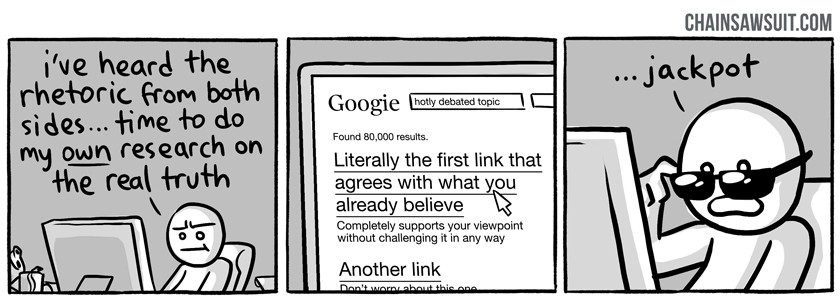In last week’s blog, I began discussing social media’s impact on our generation’s civic engagement. Essentially, social media possesses some characteristics, such as accessibility and inclusiveness, that help it reach large audiences and spread important information, but its enormous potential for profit through advertising attracts a ton of garbage. Pop culture nonsense disguised as news can outperform real journalism with click bate and misleading headlines. Today, I will discuss bias as it pertains to social media. Unfortunately, this new medium for information exchange actually feeds off the bias of the users themselves.
We can all quickly call to mind some viral Facebook hoax that fooled way too many of our friends. Personal messages from Mark Zuckerberg asking for $2.99 a month for a Facebook subscription may seem like harmless tom-foolery that tricks only the most gullible of internet newbies, but other lies are not so benign. Last November, following the terrorist attacks in Paris, a Spanish newspaper, La Razón, published the image on the left-side of the photo below on their front page after it went viral on the internet.
On the left, the allegedly muslim man wearing a vest of explosives holds a copy of the Quran while a strangely shaped shampoo bottle sits inconspicuously on the back right edge of the bathtub behind him (it is a shampoo bottle, right? right?!). On the right, we see the original image of a sikh man taking a bathroom selfie with an iPad. Its terrifying to think that thousands of people really did think that this innocent person committed one of the worst atrocities of the twenty-first century. Apparently, they didn’t even pause for a moment to consider the fact that his Quran would need a built-in camera to take the picture in the first place. When it comes to social media, people are prone to believe anything that reflects their own beliefs. Following the attacks, the global population felt anger toward Muslims and desperately wanted a face at which to direct their anger. Had everyone put in five seconds of rational thought while looking at the photo, this entire situation could have been avoided. Clearly social media users observe, form opinions, and pass judgments in a time span well under five seconds.
It turns out that this propensity to believe a conclusion more readily when it agrees with an individual’s prior base of knowledge (or opinions) is very well understood. It is called confirmation bias. Tomas Chamorro-Premuzic, a professor of business psychology at University College London, wrote an article in the Guardian focusing on confirmation bias online. He argues that since we cannot ever come close to reading all the information the internet has to offer on a certain subject, we choose to instead prioritize information based on how fully we agree with it. If you already know that you hold a certain opinion about politics, economics, or the environment, you are far more likely to read articles that confirm your current understanding because trying to get through the mountain of information that exists opposing your viewpoint is just too intimidating.
Interestingly, ego may actually act as the single largest cause of confirmation bias on the internet. Ask yourself honestly, do you hold biased viewpoints? Do you really do all you can to attain a balanced base of information? Here’s a good one: are you more biased than the average person? In a study done by researchers at Carnegie Melon University, test subjects responded to that very question. CMU reports, “The most telling finding was that everyone is affected by blind spot bias - only one adult of 661 said that he/she is more biased than the average person.” The blind spot bias affects the person you see in the mirror. Everyone thinks quite highly of his or her own intellectual neutrality and open-mindedness, but, statistically speaking, half of the people in the world have to be more biased than the average person.
The danger in the move toward obtaining news information by scrolling through Facebook or Twitter lies not in the bias of the articles themselves but in users’ inherent biases in selecting which links to anoint with a tap of their thumbs. Credible news sources must present information in at least a somewhat objective manner to maintain their reputability. Individuals, however, need not abide by the same standard. They can find and read any information they desire, and, as I have discussed, the information they seek more often echoes their beliefs back to them than stimulates critical thinking. Only a deliberate desire to value diverse viewpoints in today’s internet age will prevent our own egos from limiting our minds.



